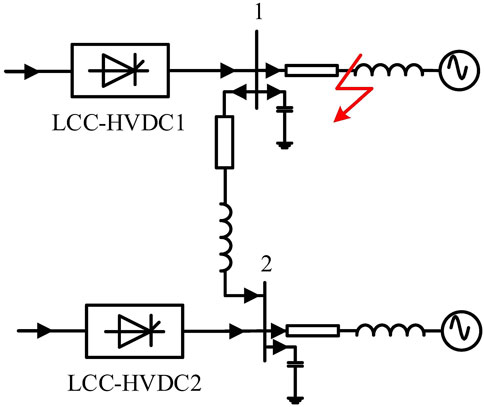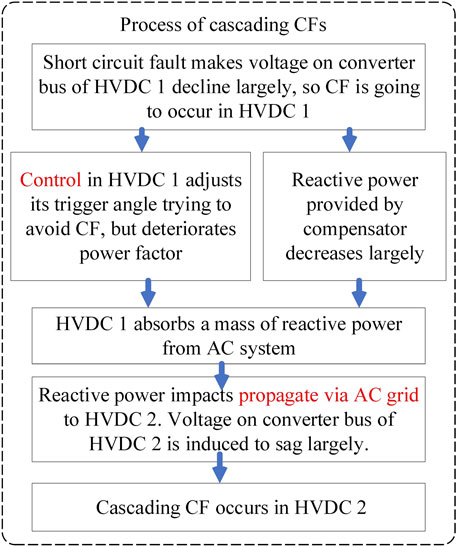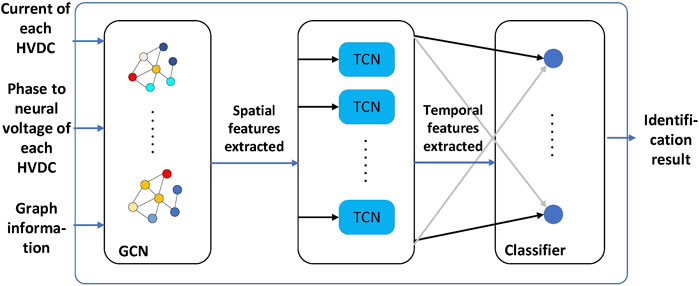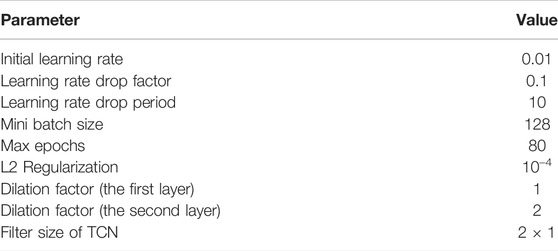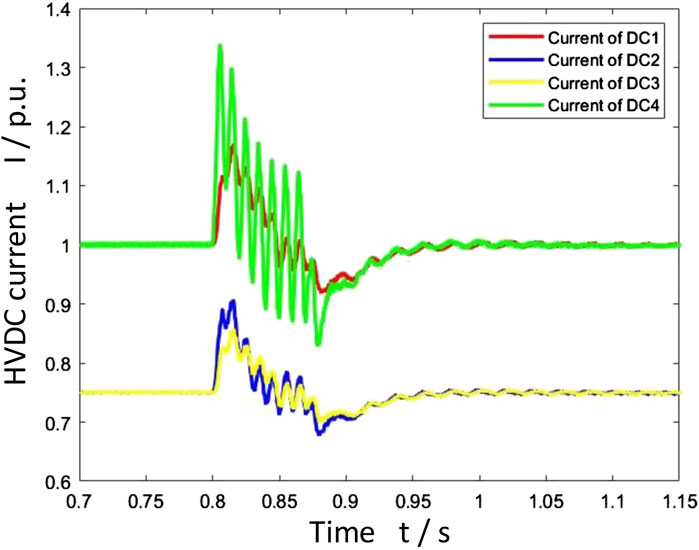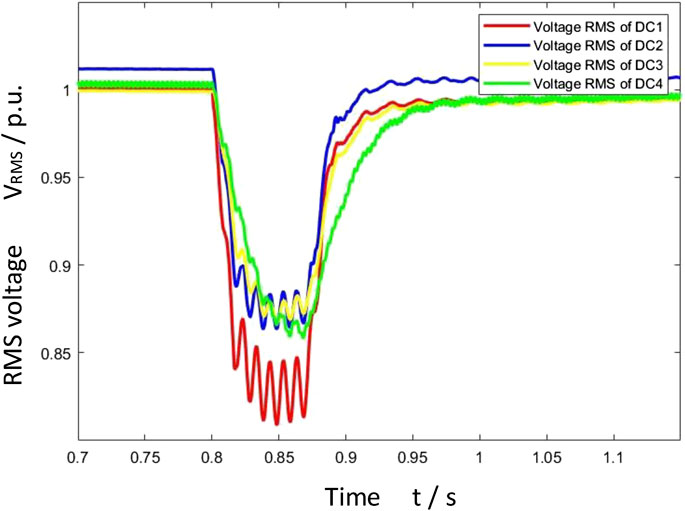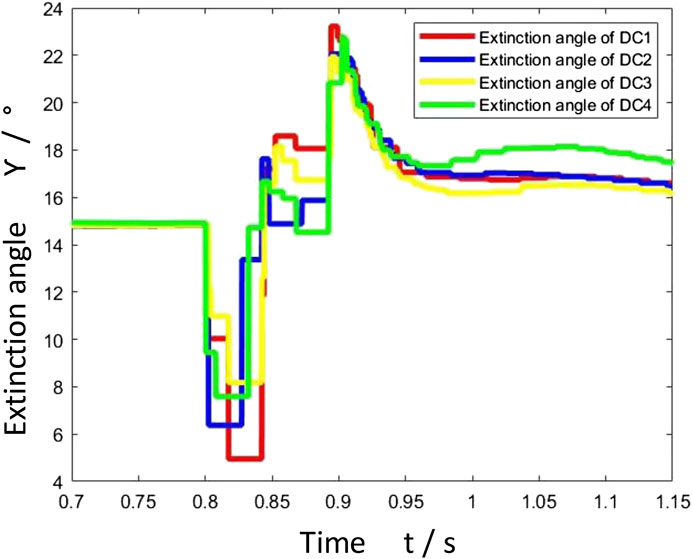- Key Laboratory of Power System Intelligent Dispatch and Control of Ministry of Education, School of Electrical Engineering, Shandong University, Jinan, China
Cascading commutation failures (CFs) pose severe risks in multi-infeed high voltage direct current (HVDC) systems. Different from the single or concurrent CF, not only the time-relevance of signals but also the spatio coupling and even control correlation of HVDCs will attribute to the cascading CFs. The conventional approaches to identify them tend to fall into a dilemma due to their complicated dynamics, wide-area coupling and vague threshold of judgement. In this paper, a deep-learning method based on the data-driven idea is proposed to recognize the cascading CFs. It analyzes the crucial factors leading to the cascading relationship of multiple HVDCs, while classifying them into time and space signals. To extract the inherent correlation between HVDCs as well as the time relevance in question, a spatio-temporal convolutional network (STCN) is formulated. The data generated in case of faults with diverse severity are applied to train STCN. Finally, the proposed framework and STCN method are validated by a customized IEEE 39 bus system and a practical power grid.
1 Introduction
The technology of line commutated converter based high voltage direct current (LCC-HVDC) plays an important role in the long distance and large capacity transmission due to its low cost and fast power regulation (Guo et al., 2012). However, the risk of cascading commutation failures (CFs) in scenario of multiple HVDCs in close proximity severely threatens modern power grid. It raises great necessity to identify them accurately so as to facilitate the protection design, mitigate the fault propagation and maintain the system stability.
The occurrence of cascading CF can be attributed to not only the voltage coupling between HVDCs via grid, but also the control of each HVDC. The latter always tries to avoid CF by adjusting the firing angle after all. However, if the voltage dynamics is too rapid for the control system to react, then CF is still inevitable. It infers that the variation of voltage over time i.e., the temporal effect is one of the factors reflecting the possibility of cascading CF. Unfortunately, such a dependence is rather difficult to be formulated analytically. Alternatively, some researches turn to apply the data-driven methods such as neural network to intelligently establish mapping. On the other hand, multiple HVDCs with different locations affect each other via voltage coupling, which forms the spatio effect. Such an effect is sometimes asymmetric with regard to multi-infeed HVDC system. It causes many classical spatio correlation networks e.g., graph convolutional network (GCN) to perform worse. With all that, there remain some issues in either temporal or spatio aspects to be solved.
Actually, the attempts to enhance the grid safety have pushed forward the studies on the identification of cascading CF in the last few decades. The literatures can be roughly classified into two types as follows. With regard to the analytical methods, the relevant reports are popular. An approach to derive the region boundary is presented for the critical CFs and the extinction angles in multi-infeed HVDC systems (Li et al., 2017), although the concurrent CFs rather than the cascading CFs are involved (Li et al., 2021). reported a supplement considering double-phase to ground and inter-phase short-circuit faults. The adverse interaction between HVDCs or buses is one of the crucial reasons leading to the cascading CFs. To quantify such effects, multiple-infeed interaction factor (MIIF) is advised by CIGRE working group (CIGRE Working Group B4.41, 2008). More generally (Xiao et al., 2020), proposes an index namely AC-DC interaction factor to evaluate the voltage coupling between AC lines and converter buses so that CF incurred by voltage distortion can be judged. In (Xiao et al., 2022), the analytical evaluation related to local and concurrent CFs is investigated with the inter-inverter interactions considered in multi-infeed LCC-HVDC systems. Since the dynamical influence from HVDC control is usually neglected in the literatures above, the misjudgments are inevitable sometimes. An approach involving the transients due to HVDC is proposed to evaluate the CF risk (Yang et al., 2020). After the dynamic reactive power of inverter stations as well as the induced successive CF is analyzed (Ouyang et al., 2021), presents a rapid prediction method based on the extinction angle of LCC-HVDC affected by the adjacent one. However, the criterion established on the analytical extinction angle is more or less difficult to be specified. Practically the dropping rate and amplitude of voltage on the converter bus are monitored in engineering to formulate the judging criterion. For instance, in case that the voltage is reduced to less than 0.8 p. u. and the dropping rate exceeds 0.3 p. u. per second, it will be deemed as the occurrence of CF (Shao et al., 2011). Once again, such a criterion is derived from a great deal of engineering experience and cannot ensure validation all the time.
On the other hand, some works reported the feasibility of artificial intelligence (AI) on the analysis of CF. By using stacked denoising autoencoder, the duration of CF can be predicted by inputting AC fault information as well as the operation status of generators, reactive power compensation and the other relevant devices (Zhu and Liu, 2019). Recently (Zhu et al., 2022) improves a fast probability estimation of successive CF. These two literatures emphasize the spatial features coupling multiple HVDCs. Cui et al. (2020) proposes an approach integrating physical-drive and data-driven model to predict the voltage drop on the converter buses and thereby judge the cascading CFs. The temporal features are extracted by data-driven model, while the spatio coupling between HVDCs is still obtained analytically. Temporal convolution network (TCN), as a cutting-edge type of deep-learning technology, drew enough attention in the scenarios of time-relevance feature-extraction, including fault diagnosis in power electronics (Gao et al., 2021; Guo et al., 2022). However, few literatures are found for it to be applied on identification of cascading CFs.
With regard to identifying the cascading CFs, previous works mostly face some dilemma. Either the judgement thresholds are difficult to confirm in an analytical way, or the AI-based approaches lack the explicit consideration of the coupling on both spatio and temporal dimension. In this paper, a novel method for the CF identification within a multi-infeed HVDC system is proposed in the particular case that they incur the cascading sequence. The contributions are summarized as follows.
(1) Based on the analysis of CFs and their coupling mechanism between HVDCs, the data-driven idea of deep learning is proposed on the identification of cascading CFs. It hopefully can overcome the difficulty in their analytical mapping and threshold setting.
(2) A hierarchical structure integrating spectral GCN and TCN is proposed. It explicitly formulates a spatio and temporal convolutional network (STCN), thereby extracting the geographical and time-relevance features of cascading CFs straightforwardly.
The rest parts of this paper are organized as follows. In Section 2, the mechanism of cascading CFs is analyzed, while the crucial factors to incur them are emphasized. In the meanwhile, the relevant features of GCN and TCN suitable for the identification of cascading CFs are pointed out. Section 3 proposes the structure of STCN and its framework so as to identify cascading CFs. In Section 4, the proposed method is validated in the customized IEEE 39 bus system and a practical grid. Finally, the paper concludes in Section 5.
2 Crucial Factors During Cascading Commutation Failure and Feasible Convolution Neural Network
2.1 Mechanism of Cascading Commutation Failure
As one of severe faults in LCC-HVDC, the occurrence of CF in a thyristor-based converter can be attributed to insufficient reverse voltage or its inadequate time-duration to shut down a valve reliably. If an AC short-circuit fault occurs near to HVDCs, CFs are probably incurred simultaneously in several converters due to the voltage dip caused by the short-circuit fault, as the grid cannot provide enough reverse voltage. Such a phenomenon is well-known as concurrent CF. However, this paper targets at another type of CFs involving multiple HVDCs, which are namely cascading CFs. Different from the concurrent CFs, the cascading CFs are ascribable to more complicated factors, including not only the disturbance due to the short-circuit fault but also the adverse coupling between HVDCs due to inappropriate control correlation.
In case that the voltage on converter bus decreases or the HVDC current increases largely, CF tends to happen. The control system within HVDC always tries to avoid CF by adjusting the trigger angle dynamically. However, the performances of control require some time to show up. If the voltage or the current changes too rapidly for the HVDC control to react, CF is still inevitable. In other words, the time-domain relevance of some crucial signals, such as the voltage on converter bus or the HVDC current, can reflect the possibility of CF in a single HVDC system.
Given a multi-infeed HVDC system e.g., the one as illustrated in Figure 1, a special kind of cascading CFs, however, demonstrates the distinct reasons of spatio interactions between HVDCs in addition of temporal factors. When a short circuit fault enough to incur a CF in HVDC 1 happens, the CFs successively appear in both HVDCs. That is to say, CF propagates from one to another HVDC. The cascading process of CFs is shown in Figure 2 with the crucial factors emphasized by colorful fonts. It infers that CFs spread via geographic AC grid and couple with each other to form the cascading failures.
With all that, the spatial and temporal features should be extracted if cascading CFs are required to be identified in multi-infeed HVDC system. Convolution networks, as a popular approach to map the inherent links of signal, can play an important role. They are classified as per their emphasis on either geography graph or temporal signals.
2.2 Spectral Graph Convolution
The geographic grid can be usually mapped into a graph, either directed or undirected. As a non-Euclid space, it is difficult to define its convolution kernel if convolution is directly applied to a graph. Hereby, a spectral convolution in Fourier domain is carried out, which converts graph data and convolution kernel to spectral domain for convolution. By introducing the normalized Laplacian matrix, the original feature distribution remains unchanged when it is multiplied by the feature matrix. The normalized Laplacian matrix holds that
where
However, it makes the convolution kernel affect the whole graph, thus losing locality. And there is still massive computation to be carried out, slowing down the training speed. In order to reduce the computation, the first-order Chebyshev polynomials (Kipf and Welling, 2017) are introduced to approximate the parameters of convolution kernels, and the convolution is formulated as follows
where
2.3 Temporal Convolutional Network
As one of the representative algorithms in deep learning, TCN demonstrates the advantages over convolution neural network and recurrent neural network, when dealing with time sequence problems (Bai et al., 2018). Due to the introduction of dilation factor, TCN can obtain a large receptive field through a shallow layer, which is conducive to the extraction of time characteristics.
When a sequential input data
where
3 Proposed Identification of Cascading Commutation Failure
As analyzed in Section 2.1, the time-relevance and the geography-relevance of signals determine the occurrence of cascading CFs. Hence, the method based on STCN to recognize the cascading CFs is proposed in this section.
3.1 Structure of Proposed STCN
Since some spatial and temporal features are required to be emphasized in the input signals, the network structure should be designed deliberately. As known, GCN integrates the graph information to extract the spatial features from the inputs, while TCN enables finding the temporal features in time series as a result of a large receptive field and a strict causal mapping. Hence, this paper proposes a structure namely STCN to recognize the cascading CFs. It hopefully combines the advantages of TCN and GCN. As illustrated in Figure 3, the structure of STCN is overall composed of a first-order GCN layer, a TCN layer and a classification layer. The GCN layer is responsible to extract the spatio correlation between HVDCs, while the TCN layer is used to enrich the temporal features. Finally, the classification layer outputs whether or not the cascading CFs are judged to occur.
To reflect the interaction between HVDCs via grid, the multiple-infeed interaction factor (MIIF) weights the graph of grid. That is to say, the adjacent matrix
GCN extracts the spatial features from the data in chronological order and it does not destroy their time sequence. The neural network structure in serial will not interfere with the temporal feature extraction at TCN. When both the temporal and spatial features are acquired, the suitable classifier should be applied to map the extracted high-order features to the corresponding judgment results of cascading CFs. This paper adopts the fully connected structure with softmax activation function as the classification layer.
3.2 Selection of Input Signals
Cascading CFs are happening in a dynamic process. It is inaccurate to make a judgement of cascading CF by using the feature of a specific moment only. When the symmetrical fault occurs in AC grid, the amplitude and the dip rate of the voltage on converter bus as well as the HVDC current affects the occurrence of CF. In case of the asymmetrical fault, not only the above factors, the phase offset and waveform distortion will also affect CF (Tang and Zheng, 2019).
The selected input signals should be streamlined enough to reflect the information involved in the existing experience fully. Therefore, the phase to neural voltage on the converter bus and the HVDC current with a certain time-duration after the fault is employed as the input characteristics. The phase to neural voltage reflects the working state of the converter station, and to a certain extent, it also contains the phase deviation information. HVDC current reflects the transmission capacity. If the information of each HVDC is input together, it contains all the spatio and temporal information in theory.
4 Case Study
In order to validate the proposed method, two cases in a customized IEEE 39 bus system and a practical power grid are established respectively in PSCAD/EMTDC to produce the required data. The proposed structure of STCN is implemented in MATLAB platform.
4.1 Validation in Customized IEEE 39 Bus System
Based on the classical IEEE 39 bus system, the inverters of two HVDC links are added to the 7th and 12th bus, respectively. The HVDCs are established as per the CIGRE standard model. The system topology is shown in Supplementary Material A.
To produce the sample data, the fault is assumed as three-phase grounding, two-phase grounding and single-phase grounding fault respectively. The fault resistance ranges from
The STCN is built. Adaptive moment estimation (ADAM) and cross entropy are used as the solver and the loss function, respectively. The hyperparameters are shown in Table 1.
In order to evaluate the performance of the proposed method, the following indices are defined in the test procedure, which are the accuracy rate (
where
Among these indices, the accuracy rate is the basic evaluating indicator to identify various situations in the test. Since CFs may lead to serious consequences, an important purpose of the proposed method is to distinguish them from normal situations. The fault recognition rate describes the ability of STCN to recognize them. The judgment in training is more stringent than in testing. That is to say, the training strategy is relatively conservative. Hence the misjudgment rate is to describe the conservative degree of the proposed method.
In order to demonstrate the improvement of the performance, the proposed method is compared with the typical full-connected network (FCN) without spatio and temporal convolution. Meanwhile it is compared with the method based on the threshold set in (Shao et al., 2011) the critical ac-dc interaction factor (CADIF) in (Xiao et al., 2020) and the critical multiple-infeed interaction factor (CMIIF) in (Wang et al., 2021) respectively. The FCN contains 3 hidden layers with 200, 50 and 4 neurons, respectively. The activation functions of the first two hidden layers are Rectified Linear Unit (ReLu), while the third hidden layer is activated by softmax function. The compared results are listed Table 2.
Although the analytical method in (Shao et al., 2011) exhibits a high fault recognition rate of 97.89%, it results in a large misjudgment rate as well. Many single CFs are misjudged as cascading CFs. This advises that the thresholds based on experience may be too conservative in other systems. The accuracy of data-driven FCN-based method without explicit extraction of spatio and temporal features is relatively better. However, some position information in the input and the correlation between the adjacent positions are destroyed to some extent, resulting in unsatisfactory results. Because the effect of control system is not considered, CADIF will incur a great error when judging cascading CFs. Alternatively, the cascading CFs can be monitored by analyzing the interaction between HVDCs (Wang et al., 2021). However, it poses the premise that the foregoing HVDC suffering from CFs is known, while the impact of AC fault on HVDC is neglected, also resulting in unsatisfactory performance. It can be found that the proposed method, compared with the four others, exhibits higher fault recognition and accuracy rates. Its performance has been significantly improved.
4.2 Validation in a Practical Power Grid
In order to verify the generality of the proposed method, a simulation case of a practical power grid is studied. The grid topology is illustrated in Supplementary Material B. Four HVDCs are fed into AC power grid which includes 21 buses with the rated voltage of 500 kV. Three-phase grounding fault, two-phase grounding fault and single-phase grounding fault are applied near to each AC bus respectively. The fault duration is 0.07s. The cascading CFs in these four HVDCs subject to different faults are analyzed.
The training strategy is identical with the previous case in Section 4.1. The performance is listed in Table 3. Inferred by the results, the proposed STCN method can still deliver a good performance in the practical power grid. This also confirms that the inputs selected meet the requirements to identify cascading CFs.
The dynamics simulation in a specific sample is investigated. This sample is with two-phase grounding fault at the 4th bus in 0.8 s, which also lasts 0.07 s, while the grounding resistance is.
Previously there were some typical approaches to recognize CFs. They are compared with the proposed STCN method in this section. If only considering the change of HVDC current (Yin and Li, 2021), suggests that the larger the current increases, the easier it tends to CF. Therefore, it can be seen from Figure 4 that CF is most likely to occur in HVDC 4. In addition, as per (Shao et al., 2011), if the voltage is less than 0.8 p. u. and the dropping rate exceeds 0.3 p. u. per second, HVDCs will be judged to suffer from CFs. Correspondingly all four HVDCs should commutate successfully, observed from Figure 5. If the ac-dc interaction factor of each HVDC is compared with the corresponding CADIF (Xiao et al., 2020), all the four HVDC are judged to suffer from CFs. When it comes to the method based on CMIIF (Wang et al., 2021), the same results of CFs are also obtained. But the above four methods apparently make mistakes. Figure 6 indicates that the extinction angles of HVDC 1 and 2 are less than 7°. The cascading CFs do occur in HVDC 1 and HVDC 2. Obviously, the incorrect results are reached on the basis of a single factor. This also explains why the method of (Shao et al., 2011) in Section 4.1 delivers a large error.
After the data from HVDC and converter bus are input into the trained STCN, the classification results are obtained. The proposed STCN does advise that HVDC 1 and 2 suffer from the cascading CFs. Compared with Figure 6, it demonstrates consistency.
In summary, the effectiveness and generality of the proposed method are confirmed. It can be inferred that the identification performance of cascading CFs is apparently promoted by the proposed STCN method.
5 Conclusion
This paper proposes a deep-learning method based on spatio-temporal convolutional network (STCN) to recognize the cascading commutation failures (CFs) in multi-infeed high voltage direct current systems. The following conclusions can be reached.
1) The cascading CFs demonstrate apparent coupling in geographic and time domain. The time-relevance of the HVDC current and the voltage on a specific converter bus represents the temporal factors leading to CFs, while the correlation of voltages and currents between different HVDCs forms spatio factors.
2) The hierarchical structure of STCN ensures the spatio and the temporal features of signals to be extracted explicitly. Thereby it is suitable for the identification of cascading CFs in multi-infeed HVDC systems.
3) The proposed method based on STCN performs better to identify the apparent cascading CFs, if compared with some conventional approaches based on classical neural network and analytical formulation.
Data Availability Statement
The raw data supporting the conclusion of this article can be provided by contacting the authors, without undue reservation.
Author Contributions
XW contributed to conception and design of the study. RL organized the training data. KS and JH built the simulation models and assisted RL in performing the analysis. XW and RL wrote the manuscript. XW contributed to manuscript revision, proofreading, and approved the submitted version.
Funding
The work is funded by the National Key R&D Program of China (Response-driven intelligent enhanced analysis and control for bulk power system stability, 2021YFB2400800).
Conflict of Interest
The authors declare that the research was conducted in the absence of any commercial or financial relationships that could be construed as a potential conflict of interest.
Publisher’s Note
All claims expressed in this article are solely those of the authors and do not necessarily represent those of their affiliated organizations, or those of the publisher, the editors and the reviewers. Any product that may be evaluated in this article, or claim that may be made by its manufacturer, is not guaranteed or endorsed by the publisher.
Supplementary Material
The Supplementary Material for this article can be found online at: https://www.frontiersin.org/articles/10.3389/fenrg.2022.960656/full#supplementary-material
References
Bai, S., Kolter, J. Z., and Koltun, V. (2018). An Empirical Evaluation of Generic Convolutional and Recurrent Networks for Sequence Modeling. E. Coli. Available at: https://arxiv.org/abs/1803.01271 (Accessed Apr 19, 2018).
Cui, H., Tang, Y., Duan, F., Wang, Q., and Yang, Y. (2020). “Fast Prediction of Cascading Commutation Failure in Multi-Infeed HVDC System by Integrating Data-Driven Method and Model-Driven Method,” in 2020 IEEE 4th Conference on Energy Internet and Energy System Integration (EI2), Wuhan, China, October, 2020. 3243–3247. doi:10.1109/ei250167.2020.9346869
Dong, X., Sun, Y., Li, Y., Wang, X., and Pu, T. (2022). Spatio-Temporal Convolutional Network Based Power Forecasting of Multiple Wind Farms. J. Mod. Power Syst. Clean Energy 10 (2), 388–398. doi:10.35833/mpce.2020.000849
Gao, S., Wang, Q., and Zhang, Y. (2021). Rolling Bearing Fault Diagnosis Based on CEEMDAN and Refined Composite Multiscale Fuzzy Entropy. IEEE Trans. Instrum. Meas. 70, 1–8. doi:10.1109/tim.2021.3072138
Guo, C., Zhang, Y., Gole, A. M., and Zhao, C. (2012). Analysis of Dual-Infeed HVDC with LCC-HVDC and VSC-HVDC. IEEE Trans. Power Deliv. 27 (3), 1529–1537. doi:10.1109/tpwrd.2012.2189139
Guo, Q., Zhang, X., Li, J., and Li, G. (2022). Fault Diagnosis of Modular Multilevel Converter Based on Adaptive Chirp Mode Decomposition and Temporal Convolutional Network. Eng. Appl. Artif. Intell. 107, 104544. doi:10.1016/j.engappai.2021.104544
Kipf, T. N., and Welling, M. (2017). “Semi-Supervised Classification with Graph Convolutional Networks,” in Conference Track Proceedings of 5th International Conference on Learning Representations, Toulon, France, April, 2017. 1–14.
Li, G., Zhang, S., Jiang, T., Chen, H., and Li, X. (2017). “A Method of Detecting Commutation Failure in Multi-Infeed HVDC Systems Based on Critical Failure Impedance Boundary,” in 2017 IEEE Power & Energy Society General Meeting, Chicago, United States, February, 2018. 1–5. doi:10.1109/PESGM.2017.8273890
Li, G., Zhang, S., Li, S., Liu, X. X., and Xintong, L. (2021). Determining Region Boundaries of Critical Commutation Failures in Multi-Infeed HVDC Systems under Unbalanced Short Circuit Faults. Front. Energy Res. 9, 635010. doi:10.3389/fenrg.2021.635010
Ouyang, J., Pang, M., Zhang, Z., Ye, J., and Diao, Y. (2021). Prediction Method of Successive Commutation Failure for Multi-Infeed High Voltage Direct Current Systems under Fault of Weak Receiving-End Grid. Int. J. Electr. Power Energy Syst. 133, 1–9. doi:10.1016/j.ijepes.2021.107313
Shao, Y., Tang, Y., Guo, X., and Zhou, Q. (2011). Analysis on Commutation Failures in Multi-Infeed HVDC Transmission Systems in North China and East China Power Grids Planned for UHV Power Grids in 2015. Power Syst. Technol. 35 (10), 9–15. doi:10.13335/j.1000-3673.pst.2011.10.023
Tang, Y., and Zheng, C. (2019). Review on Influencing Factors of Commutation Failure in HVDC Systems. Proc. CSEE 39 (02), 499–513+647. doi:10.13334/j.0258-8013.pcsee.180326
Wang, X., Bai, Y., Zhang, Y., Gao, F., and Liu, D. (2021). Suppression Method of Cascading Commutation Failure in Multi-Infeed HVDC System Based on Temporary Impedance Regulation of Transmission Lines. Automation Electr. Power Syst. 45 (2), 130–138. doi:10.7500/AEPS20200606001
Xiao, H., Duan, X., and Li, Y. (2022). Analytically Evaluating the Impact of Voltage Stability on Commutation Failure in Multi-Infeed LCC-HVDC Systems. IEEE Trans. Power Deliv. 37 (1), 496–506. doi:10.1109/tpwrd.2021.3063789
Xiao, H., Li, Y., Gole, A. M., and Duan, X. (2020). Computationally Efficient and Accurate Approach for Commutation Failure Risk Areas Identification in Multi-Infeed LCC-HVDC Systems. IEEE Trans. Power Electron. 35 (5), 5238–5253. doi:10.1109/tpel.2019.2943182
Yang, W., Miao, S., Zhang, S., Yaowang, L., Ji, H., Hanping, X., et al. (2020). A Commutation Failure Risk Analysis Method Considering the Interaction of Inverter Stations. Int. J. Electr. Power Energy Syst. 120, 1–14. doi:10.1016/j.ijepes.2020.106009
Yin, C., and Li, F. (2021). A Novel Evaluation Method for the Risk of Simultaneous Commutation Failure in Multi-Infeed HVDC-Systems that Considers DC Current Rise. Int. J. Electr. Power & Energy Syst. 131, 107051. doi:10.1016/j.ijepes.2021.107051
Zhu, Y., Liu, T., Li, C., and Liu, Y. (2022). Fast Probability Estimation of HVDC Successive Commutation Failure Caused by AC Grid Cascading Failures. Int. J. Electr. Power & Energy Syst. 135, 1–10. doi:10.1016/j.ijepes.2021.107618
Keywords: HVDC, cascading commutation failure, graph convolutional network, temporal convolutional network, spatio-temporal convolutional network, deep learning, data-driven method
Citation: Wang X, Lin R, Song K and Han J (2022) Spatio-Temporal Convolutional Network Based Identification of Voltage-Coupling Commutation Failures in Multi-Infeed HVDC Systems. Front. Energy Res. 10:960656. doi: 10.3389/fenrg.2022.960656
Received: 03 June 2022; Accepted: 23 June 2022;
Published: 14 July 2022.
Edited by:
Jun Liu, Xi’an Jiaotong University, ChinaReviewed by:
Zongsheng Zheng, Sichuan University, ChinaKe Jia, North China Electric Power University, China
Copyright © 2022 Wang, Lin, Song and Han. This is an open-access article distributed under the terms of the Creative Commons Attribution License (CC BY). The use, distribution or reproduction in other forums is permitted, provided the original author(s) and the copyright owner(s) are credited and that the original publication in this journal is cited, in accordance with accepted academic practice. No use, distribution or reproduction is permitted which does not comply with these terms.
*Correspondence: Renmao Lin, bGlucmVubWFvQG1haWwuc2R1LmVkdS5jbg==
 Xiaohui Wang
Xiaohui Wang Renmao Lin
Renmao Lin Kaige Song
Kaige Song Jiyao Han
Jiyao Han